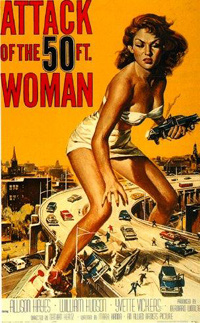| Sinemagination
Researched Imagination Prompts
e301 sinematic bodies Talmase y Nericcio, inc. We begin with a snapshot of an intellectual theft: the particulars of this sinematic writing prompt borrow ideas from the intellectual imagination of Gore Vidal--and one can easily pilfer ideas from shoddier sources. Vidal, in one of his countless essays, looks into the murky past of that scary word essay and finds another word not usually associated with the term. That word is "attempt." Where all too often one imagines an essay as a finished product, Vidal argues that the emphasis for a writer in confronting the challenge of the essay should be less product and more process, less clear conclusions, than messy, delicious and invigorating questions. You see, most people think of an
essay as a finished product--a dull, lifeless, inert textual body with
a static introduction, an "A-B-C" body, and a clear, let's-tie-up-all-the-pieces
conclusion.
You will not write this kind of essay for our sinemadness odyssey. That's right, I am asking with no little nostalgia to return to the origins of the essay. Your only task is to make a sincere attempt to produce a set of ordered reflections, a group of carefully arranged tasty words which respond in some way to the novels, films, short critical treatments and lectures you have worked through and will continue to work through in the coming weeks--much better than tidy conclusions, preferable to the facade of master, will be the accomplishment of wrangling with provocative questions. That indeed, paradoxical as it might seem on the surface, be the KEY to the perfect essay: the construction of a question that cannot be perfectly answered, but in the performance of which raises readers to a new level of understanding! Are you writing for Bill Nericcio
and Tricia Almase?
In a way, of course you are. But in order to do well on this assignment, you must forget about your peculiar, if affable, intellectual guides. The only people who really count are the readers you write for: the audience for your paper--in short, YOUR READER. Who is she? What is he like? Well, regardless of his or her various genitalic configuration, he and she are a lot like you. When it comes to reading, they are impatient and easily bored. They like specific details; they love direct, succinct quotes woven carefully into the fabric of an essay. If you are going to write about an image, they want to see a reproduction of that image. They hate misspellings and passive verbs. They like tangy language which is fresh and not filled with stupid, tired phrases. Like you, they resent having their time wasted. Regardless of which prompt grabs your eye, there is a Research component to this exercise--you should consult, cite and interweave material from at least two (2) outside published scholarly sources that relate explicitly to the particular thesis your essay unfolds-- acceptable research materials include: scholarly books and essays in academic journals--cite these sources using the MLA Bibliography style sheet. Please DO NOT merely quote from a local newspaper or unedited online zine you find through GOOGLE on the Internet. (NOTE: I WOULD PREFER YOU NOT USE ONLINE RESEARCH RESOURCES NOR ENCYCLOPEDIAS; I ACTUALLY WANT YOU TO CAREFULLY AND WITH PLEASURE USE THE LIBRARY--walk through the corridors of books and get lost even. Some good starting places for published scholarly approaches to the materials in this class are the Modern Language Association Bibliography and the ProQuest Research Library, available online through Love Library: http://infodome.sdsu.edu/research/databases/databases.shtml.** **ProQuest is good for lazy researchers in that it archives full text versions of published scholarly articles, saving you the bother of finding out if Love Library carries the journals cited in the MLA Bibliography--heck, even some of my articles are indexed on ProQuest. However, there is no substitute, even in this the high age of cyber fetishization, there is NO substitute for physically prowling the library stacks for salient critical artifacts. Please throw yourself into the pleasure of writing this paper! Take chances and don't hold back--the best A+ essays will probably be efforts where the student, that's right YOU, adapts, warps, refracts, and/or re-imagines the questions provided. You should use no less than 5 and no more than 8 pages (double-spaced typed, carefully proofread, with a dynamic, suggestive title) to complete your task. No cover sheet or folder-cover is necessary and late papers will NOT be accepted. The completed essay is due Friday, April 28, 2006 @ 12noon in the special box in front of my office, AH4117--no late papers accepted; no emailed papers accepted. Here are your prompts--you are welcome to adapt them as you see fit, especially if it means you producing a work of art that will blow your reader out of the water with excitement, enthusiasm, and ecstacy. NOTE 1: all essays that focus on works that are visual (film, photography, etc) MUST include the source for all visual works in the bibliography or in captions under the selected images. NOTE 2! I highly encourage you to illustrate your forays into rhetorical sinemadness!!!!! PROMPTS ROLL YOUR OWN ESSAY
PHARMAKOS--POISON OR CURE Jacques Derrida writes in DISSEMINATIONS in an essay on the PHARMAKOS (pharmacy) that the Greek word has in it elements that suggest both cure and poison; it strikes me that cinema, especially in the works rounded up for our class, has this configuration in its own DNA. Select three authors/artists from the required works and explore this idea in dramatic fashion. SINNING PSYCHES
MAD MEN and a CANVAS
SEXY BEASTS
MOVIE MONSTERS
SADISM, MASOCHISM AND SADO-MASOCHISM
ART AND THE SELF
|



